7. Search Patterns
7.1 Initial information and action
- Fast Rescue Craft’s (Fast Rescue Boats) have been used in the marine industries for many years now, on Offshore Installations, RO/RO vessels, Stand by Vessels, passenger Ferries, Tankers, shore side Fire departments, and in Search and Rescue. The Unique characteristics allows these boats to be launched and recovered quickly because of their light weight and high horsepower. They can be used or aid in:
MOB situations - Marshaling life rafts
- Assisting in Search Operations.
- Evacuations.
- Rescue Operations.
- Transferring Casualties.
- Towing distressed small craft.
It is the responsibilities of every mariner to respond to persons in distress. Upon hearing the MAYDAY all vessels in the immediate are to respond or stand by to offer assistance. The Rescue boat Muster list, Crew members need to know their duties.
Upon hearing the MAYDAY:
- Acknowledge the MAYDAY and alter course towards the distress
- Sound the alarm, followed by internal communications.
- Have rescue boat team muster
- Crew unlash and prepare Painter, while rescue boat team are getting dressed
- Place Radio, SART, EPIRB in the craft
- Radio Checks done and communications established
- Ready for lowering (Wait for Masters orders)
The Coxswain is Responsible for his crew’s safety, it is his decision to determine if it is too dangerous to launch.
A contingency plan should be in place in case of a boat malfunction, increment weather etc. It may be safer to bring the ship to the person, raft or vessel. The use of line throwing apparatus, life rafts or lowering the boat to the water without personnel in it can be just as efficient.
7.2 Search Patterns
Duties while Searching
Rescue does not happen in nice weather conditions with good visibility! It usually happens in deteriorated weather conditions with poor visibility and choppy sea states. Every crew member should practice his/ her skills regularly. Know your boats, capabilities and limitations! If the craft has electronic navigation on it, refer to its manual. If the ship is sending you bearings, know how to apply them. Someone may be happy you did!
Bearings
Bearings are all given in relationship from the FRC. For example, Off the Port bow of the Starboard Beam etc.
Duties of Lookouts
Crew are to be the eyes and ears for the coxswain by pointing in the direction of the person or casualty in the water, or sound that may be heard.
Duties of coxswain
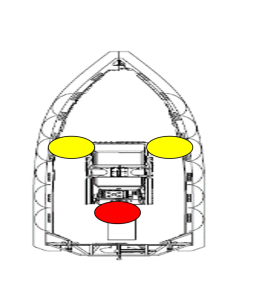
In charge of FRC and to maintain a compass course to steer and alter appropriately in the direction the lookouts are pointing, check compass heading and report to the Bridge. Overall responsible for the safety of the crew and casualty.
Factors for search:
Datum
- Size of object, person, life raft, or boat
- Current or tide
- Wind direction
- Visibility
- Depth
| Table 7.1 The distance visible to the horizon from different heights.[1] | |
| Height of Eye from Sea Level | Distance to Horizon |
| 1 Foot | 1.31 miles |
| 2 Feet | 1.87 miles |
| 3 Feet | 2.29 miles |
| 4 feet | 2.50 miles |
| 5 Feet | 2.96 miles |
| 6 feet | 3.24 miles |
| 7 Feet | 3.46 miles |
The table gives value of how far the eye can see from the water.
International aeronautical Merchant Ship Search and Rescue Manual uses the following Search Patterns for search and rescue.
- Expanding square or Box Search
- Parallel Search
- Sector Search
Expanding Square Search
This type of search is used with one ship, the ship is underway at a set speed and distance or time from datum to alter for each leg. It is important not to change speed during searches. Use “Cardinal points”.
Examples:
- Run for 15 minutes at 10 knots
- Alter course 90° to starboard
- Run for 15 minutes
- Alter course 90° to starboard
- Run for 30 minutes
- Alter course 90° to starboard
- Run for 30 minutes
- Alter course 90° to starboard
- Run for 45 minutes
- Alter course 90° to starboard
- Run for 45 minutes
- Then alter course 90° to starboard
- Run for 1 hour
- Alter course 90° to starboard
- Run for 1 hour
Keeping in mind current, wind and tide may cause the person/s to drift faster than the search if speed is too low.
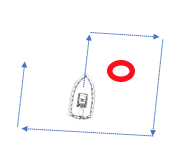
Parallel Search
This type of search is used by 1 or more ships and starts from datum and have communications set to a common frequency and the on-scene commander will regulate the alteration times.
Examples:
- Run for 15 minutes at 10 knots
- Alter course 90° to starboard
- Run for 30 minutes
- Alter course 90° to Starboard
- Run for 1 Hour
- Alter course 90° to Port
- Run for 30 minutes
- Alter course 90° to Port
- Run for 1 Hour
- Alter course 90° to starboard
- Run for 30 minutes
- Then alter course 90° to starboard
- Run for 1 hour
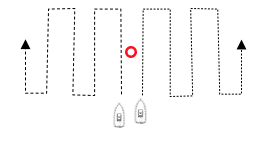
Sector Search
This type of Search pattern is used in Person /s overboard / MOB situation’s with approximate datum. Wind, current and time of incident should be taken into account to relate the time of course legs.
Examples:
- Steer 000° for 30 minutes at 5 knots
- Alter starboard to 120°
- Steer 120° for 30 minutes
- Alter starboard to 120°
- Steer 240° for 1 hour
- Alter starboard to 120°
- Steer 000° for 30 minutes
- Alter starboard to 120°
- Steer 120° for 1 hour
- Alter starboard to 120°
- Steer 240° 30 minutes
- Alter starboard to 120°
- Steer 000° for 30 minutes
- Alter course 30°
- Steer 030° for 30 minutes
- Alter 120° for 30 minutes
- Keep adding 120° until a second sector is completed.
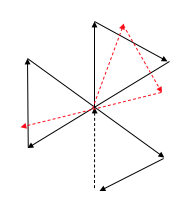
Par buckling: (A continuous piece of rope) is one of the easiest, inexpensive ways to bring the casualty in to the FRC from the water. It allows for a quick response and can reduce the risk of back injuries for the rescuer. Pass the center around conscious casualty and under arm pits, while holding on to both ends, weave the bights in and out and give lower freeboard by getting the weight to casualty side and lift. This is not recommended as the preferred method for a casualty that has been in the water for a long period of time because the hydro static pressure on the casualty’s blood vessels may put them into Cardiac Arrest.

Dacon Frame or equivalent: (rope ladder) etc. This is the safest method for the rescuers and casualty because it keeps the casualty in the horizontal position from the water until they are in the boat.
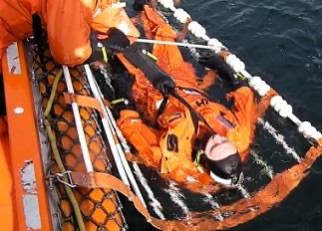
Man Overboard situations seldom happen with a person wearing some sort of flotation device on! Which means to spot a person in the water with plain clothes may be very hard to see unless it was a very smooth sea state, and other times there may be multiple persons in the water, which will be wearing highly visible flotation devices. This will then assess the need for prioritizing rescues of the casualties in the water. Prioritizing casualties in the water DOES NOT MEAN to save them, for last! It means to remove the persons as quickly as possible from that environment.
Retrieving a conscious casualty from the water
At no time should a crew member leave the FRC to assist in the water, unless they are tethered to a Line. Wind, current and Sea direction may make it hard for retrieval; Stemming the sea or wind for the approach makes it easier and safer for the coxswain and crew and remember to always have the casualty insight!
While steering directly to the casualty ensure one hand is on the wheel and the other on the Jet Controller. When taking all power off a jet drive, the steering is unresponsive and if outboards are being used, propellers can cause severe injuries to the casualty.

The Best place for retrieval
Depending on the layout of the recovery spot on the boat, the retrieval should be on the same side as the Jet controller on the forward shoulder or abeam of the coxswain. This is the safest spot for recovery on most FRC’s.
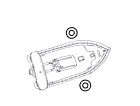
7.4 Casualty Care
Casualties that are brought on board from the sea require immediate help from crew members, assessing the vital signs: A, B, C’s has to be done as soon as they are lying down. Do Not remove wet clothes in an open boat with cold temperatures, put more on them or put them in a TPA.
Symptoms of Hypothermia
Mild Hypothermia
If someone has mild hypothermia (generally with a body temperature of 32-35˚C), the symptoms aren’t always obvious, but they can include:
- constant shivering
- tiredness
- low energy
- cold or pale skin
- fast breathing (hyperventilation)
Treatment for mild cases: the victim should be encouraged to stay active. Wet clothes should be stripped off and replaced with warm, dry clothes. It is imperative that the person’s head be covered. The victim should drink some warm (not hot), sugary fluids.
Moderate Hypothermia
Moderate cases of hypothermia (generally with a body temperature of 28-32˚C) can include symptoms such as:
- being unable to think or pay attention
- confusion
- loss of judgment and reasoning (someone with hypothermia may decide to remove
- clothing despite being very cold)
- difficulty moving around
- loss of co-ordination
- drowsiness
- slurred speech
- slow, shallow breathing (hypoventilation)
People with a body temperature of 32˚C or lower will usually stop shivering completely. This is a sign that their condition is deteriorating, and emergency medical help is required.
Treatment for moderate hypothermia: the victim should be as sheltered as possible, preferably in a cabin. Wet clothing should be removed and replaced with as much warm, dry clothing as possible. All extremities should be completely covered. If the victim is able to swallow without danger, he/she should drink warm (not hot) sugary fluids. If possible, warm objects such as water bottles, should be placed next to the victim’s groin, head, neck, and chest. The victim should be evacuated to a hospital as soon as possible.
Severe hypothermia
The symptoms of severe hypothermia (a body temperature of below 28˚C) can include:
- unconsciousness
- shallow or no breathing
- weak, irregular or no pulse
- dilated pupils
People in severe hypothermia are often mistaken for dead. Heartbeat, pulse, and respiration may not be apparent. Severely hypothermic patients must be treated very gently.
Treatment for severe Hypothermia: Cold clothing should be cut away and replaced with warm, dry clothing. No attempt should be made to re-warm the victim until he/she has been evacuated to a warm and dry shelter – preferably a medical facility. CPR should be administered if possible. Hope should not be lost; hypothermia is an amazing self-preservation technique of the human body. Severely hypothermic victims have been brought back to consciousness hours after losing all signs of life.
Assessing the signs
- Airway
- Breathing
- Circulation
An FRB is not the best place for CPR or AR but remember that if you are more than 4 minutes to a medical facility, chances of brain damage is increased considerably. CPR and AR will bring the oxygenated blood to the brain and may sustain their condition until passed over to medical help.
Frostbite: With frostbite the tissues of the extremities – usually the toes and the fingers – freeze due to low temperatures. In severe cases, it can lead to a permanent loss of sensation and, eventually, tissue death (gangrene) as the blood vessels become irreversibly damaged.
Treatment: If possible, move the casualty into the warmth before you thaw the affected part. Gently remove rings, gloves and any other constrictions such as boots. Warm the affected part with your hands on your lap, or under the casualty’s armpits. Rubbing the affected areas must be avoided as this can damage the skin and other tissues.
The FRB is equipped with thermal protective aids (TPA). Don them in one and put them in the forward part of the boat.
Stages of Hypothermia
There are four clear stages of immersion in which death can occur:
- Initial immersion or cold shock – On initial immersion, there is a large aspiratory gasp followed by a four-fold increase in pulmonary ventilation, i.e., severe hyperventilation. This on its own can cause small muscle spasms and drowning. Along with this, there is a massive increase in heart rate and blood pressure. These latter cardiac responses may cause death, particularly in older, less healthy people. These effects last for the first two to three minutes, just at the critical stage of ship abandonment. The cause of death – Drowning, heart (circulatory) and respiratory problems.
- Short-term immersion or swimming failure – Death at this stage, between three and thirty minutes after immersion, appears to affect those who try to swim. It is also known that even good swimmers may be unable to swim for more than a few minutes in very cold water. The cause of death- Impaired physical performance leading to inability to self-help, swimming failure and drowning.
- Long-term immersion or hypothermia – After thirty minutes or more of immersion, death may occur from hypothermia. The reason for this is that water has a specific heat 1000 times that of air and a thermal conductivity of about 25 times that of air. Thus, when a body is immersed in water below body temperature (37ºC), it will inevitably cool to hypothermic levels at a rate dependent on.
-
- Temperature differential
- Clothing insulation
- Rate of agitation of the water
- Body heat production produced by shivering and exercise
- Ratio of body mass to surface area
- Subcutaneous fat thickness
- State of physical fitness
- Diet prior to immersion
- Physical behavior and body posture in the water
- The cause of death- Deep body cooling leading to hypothermia and drowning.
- Post-rescue collapse – Up to twenty percent of immersion deaths occur during extraction from the water, or within hours after rescue
The cause of death-Collapse of arterial blood pressure leading to cardiac arrest. If at all possible, lift the person from the water in the horizontal position.
Major areas of heat loss
- Neck and Head-Most of the heat lost (Wear a hat). 50% heat loss
- Armpits and groin-The HELP/ Huddle position will reduce the onset. 28% heat loss
- Abdomen and sides- Clothing will provide insulation. 15% heat loss
The Causes of Hypothermia
The Human body uses basic physics for balance Heat flows down a thermal gradient from high to low temperatures. Thus, in the cold, a thermal gradient is established, down which heat “flows” from the warmer deeper tissues to the cooler tissues near the surface of the body. Heat then escapes from the body to the environment. In normal circumstances in air, the body can exchange heat with the environment via four physical processes:
- Radiation – All objects possessing heat, including the body, emit thermal radiation from their surfaces.
- Convection – This is the process by which heat is exchanged with the environment by the movement of air or water molecules adjacent to the skin, as they move away, they are replaced by colder molecules.
- Conduction – This term is used to describe heat exchange between the skin and surrounding surfaces with which it is in direct contact.
- Evaporation – Evaporation is the process by which energy transforms liquidto a gas. The heat required to drive this process is removed from the surface of the object on which evaporation is occurring, and it cools.
7.6 Helicopter Operations
Communications
Between SAR Helicopter and FRB will be set by the Helios prior to arrival for a working channel.
- The SAR will indicate course to steer and speed.
- Coxswains make sure all loose gear is stored and have casualty moved to the largest deck area, usually the bow.
- Make sure your search light is pointing on the deck when they approach and off when they illuminate the FRB and maintain the same heading.
- Be ready to help the SARTEC onboard. Always keep winch operator in helicopter insight.
Signaling
With the noise of the props signaling will be imperative for communications. Use the following signals.
Preparations: The FRB must have all loose material stowed such as TPA, and lines prior to helicopter arrival. This includes VHF whips and radar on stand-by. Ensure casualty has life jacket on.
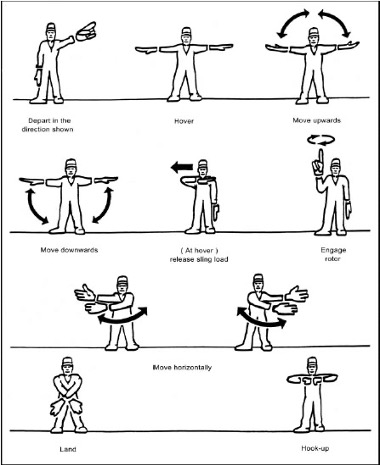
Method of Transfer
The FRB has to be moving for the Transfer, because the down draft would be too great. If the SARTEC can land on your deck, they will ground out first by touching the water, this will be communicated with pilot. The SARTEC will either have a double strop depending on the casualty’s condition or may be a basket, or litter. If the FRB is in real proximity to land, he may have you follow his course for a better transfer.
Image Credits
- Marinelink. (2013, June 18). The Dacon Rescue Scoop and the Dacon Rescue Frame.
https://www.marinelink.com/news/equipment-safety-supply355954 - Transport Canada. (2006). Helicopter Flight Training Manual (TP 9982),p.111. https://tc.canada.ca/sites/default/files/migrated/tp9982e.pdf
- Totally Cuckoo. (n.d.). The distance visible to the horizon from different heights. http://www.totally-cuckoo.com/distance_visible_to_the_horizon.htm ↵
